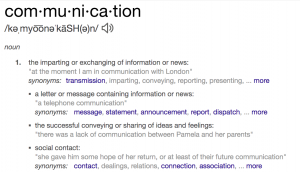
Teaching staff establish and strengthen relationships with families by 1) communicating with them about the instructional program, 2) conferring with them about individual student learning progress, and 3) inviting them to be a part of the educational process itself.
Before we consider “what works” in supporting family communication during in these early years, let’s take a look at how The Framework for Teaching focuses on this critical aspect of teaching in 4c: Communicating with Families.
The elements of 4c: Communicating with Families are:
- Information about the instructional program. The teacher frequently provides information to families about the instructional program
- Information about individual students. The teacher frequently provides information to families about students’ individual progress.
- Engagement of families in the instructional program. The teacher frequently and successfully offers engagement opportunities to families so that they can participate in the learning activities.
The Indicators of 4c: Communicating with Families include:
- Frequent and culturally appropriate information sent home regarding the instructional program and student progress
- Two-way communication between the teacher and families
- Frequent opportunities for families to engage in the learning process
Want to add some different tools for enhancing your 4c: Communicating with Families to your Teaching Toolkit? Here are a variety of approaches and resources to consider:
Example 1: Early Learning DEEP Family Involvement
In this family-teacher conversation, (which is a follow-up to a recent parent conference), one of Sophia and June’s families share the changes that they have seen in their child since coming to the center at age two, when he was not talking, to now at age four being on target to go into a regular Kindergarten classroom without additional learning supports. Special family learning supports that are emphasized in the conversation include:
- Weekly Family Letter with Family Feedback Form (both in English and Spanish)
- Monthly Family “Look Aheads” Newsletter
- Welcome to Our Classroom Letter from Ms Sophia and Ms June
- Invitation to Family Involvement Events
- Family Communication Travel Folder
PLUS take a look at how Sophia keeps track of family feedback week-by-week:
- Example of Sophia’s Weekly Journaling of Family Feedback from newsletter/notes
Example 2: Technology Enhanced Student-Family Communication
In Valeksa’s Parent Connection, one of Valeska’s students share how she and the other students in the class communicate learning progress using a technology tool called See Saw (an IPAD-based, video student learning portfolio platform). Take a look at how this first grader captures, narrates and sends her learning progress to her family in “real learning time” in order to provide opportunities for her family to engage in her learning progress.
Example 3: Preparing for Family Conferences in the Early Learning Grades
This tip sheet, developed by the Global Family Research Project, Harvard University, outlines what principals, teachers, and parents can do to better prepare for and make the most of parent-teacher conferences. These meetings, usually held in the fall, are just one part of successful family engagement programs, which also include working with parents as partners in understanding data related to their children’s progress—both in and out of school. Take a look and see how you might use this resource to form stronger connections with the families in your school.
Example 4: Early Elementary Family-Teacher Shared AND Student-Led Conferences
In this family-teacher conference, Kaia, the student, and Mr Frankel, the teacher, co-conference about learning goals that she has mastered and how she is setting new goals in math and reading. Mr Frankel prompts Kaia to share her thinking with her parents not only about “what” new goals she is setting but also “why” these goals are just right to continue to support her learning growth. The Student Learning Goal documentation that was used in the parent conference includes 1) Kaia’s Personalized Learning Plan (p1); 2) Student Goal Setting Worksheet (p. 2); and 3) NWEA Map Student Progress Report (p3)
If your school/district requires student-led conferences OR you just want to organize your Parent conferences in this manner, here are really helpful resources:
- Student-Led Conferences: Resources for Educators via Edutopia
- Best Practices for Student-Led Conferences via Edmentum
- The Student-Led Parent-Teacher Conference via Shmoop
- When Students Lead Parent-Teacher Conferences via ASCD’s Educational Leadership
- A Step-by-Step Plan for Student-Led Conferences at the Elementary Level via Teaching Channel
Last thought…4c is ALL about communicating to engage families in the student learning process. What is your approach? . How will you define family communication this year?

